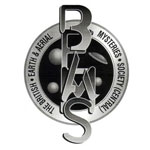Steyning Village, West Sussex and 'The
People of The Stones'
[Please scroll completely down this page for full story and photos]
The name of Steyning is thought to have arrived from "people of the stone" - or "stones", and in the porch of St Andrew's Church there can be found a curious artifact, the true significance of which has so far proved elusive to academia.
Both Pagan and Christian origins have been proposed for this stone carving, which legend has it was originally "taken from a high place"; and when one stands in Steyning and looks around, the only obvious "high place" near here is Chanctonbury Hill, (home of the mystical Chanctonbury Ring site), which towers 781 feet above sea level over this quaint village.

"Taken from a high place"
Quote from Standing Stones in Sussex: "At first glance it appears to be but a grave slab, but it has been pointed out that the top is weathered but the bottom is not, which would suggest that it has been standing rather than lying on the ground.
He also points out that the cross motif near the center of the stone, the only recognisable Christian symbol, is cut deeper than the other symbols. This he says [seems] to be a later addition, used to 'Christianise' the otherwise pagan stone." end.
This object has previously been referred to in writings as either a "Standing Stone" or a "Menhir".
The above excerpt is used to show how our investigation is clearly not about a mere grave slab; yet, (just as if to confuse matters), there is a grave slab to be found here at this church, (a far thinner, broken stone - see picture below) which is also located iin the porch: It is known as the 'royal grave-slab', and is usually associated with Ęthelwulf of Wessex. Ęthelwulf was buried here in 858, being transferred to Winchester at a later date.
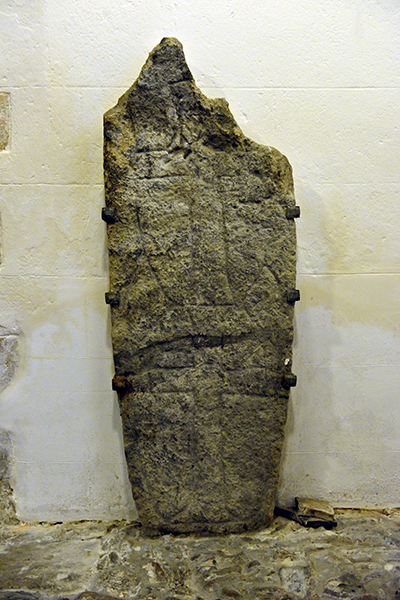
Broken grave slab in Steyning church;
this has two Christian crosses crudely scored into it
and is not in any way comparable to its neighbour
in terms of workmanship.
The two stones are not associated as far as we can
determine - and may not even be the same age.
Together with my partner Hilary, I have stayed at Steyning many times and studied its history in
great depth; and we can reveal to the reader our conclusion that this stone once stood upon Chanctonbury Ring, from whence it was removed, then disguised and placed where it was later discovered during renovation work in 1938... face down and being used as a church step.
We even visited the local museum, (located just across the road from St. Andrew's), to try and find out what they knew about this mysterious artifact, but the staff there seemed most reluctant to elaborate - one of whom even replied "what stone?" when I first dared to ask about it.
Renaming Fiasco
Our inquiring minds were puzzled as to why this pagan creation might have been ripped out from
the Chanctonbury hilltop and taken to a place of Christian sanctity.
It doesn't exactly stretch the bounds of possibility to suggest that the clergy should be our
Number 1 suspects in this whodunnit; an idea further bolstered by a local story that tells how "St. Cuthman felled a stone, which the people of Steyning were worshiping" and "built the first church there around 750 AD."
The building was reconstructed beginning from about 1200 AD, but naturally it was still known as
St. Cuthman's; yet only recently there was a radical attempt to change its denominational reference; even though Cuthman was the founder of this site, it was decided by someone to re-dedicated the church St Andrew's; yet moves began in January 2007 within the parish to have it rededicated to "St Andrew and St Cuthman", giving the apostle Andrew precedence, but reincluding Cuthmann; these moves succeeded and the church is now dedicated to "St Andrew and St Cuthman".
Trampled Under Foot
Trampling on a sacred item has always been considered as an incredibly offensive act, and the
placing of this overturned stone for use as a church step might well have been a symbolic, disrespectful gesture by Cuthman, against what were considered at that time - 'sacrilegious heathens'.
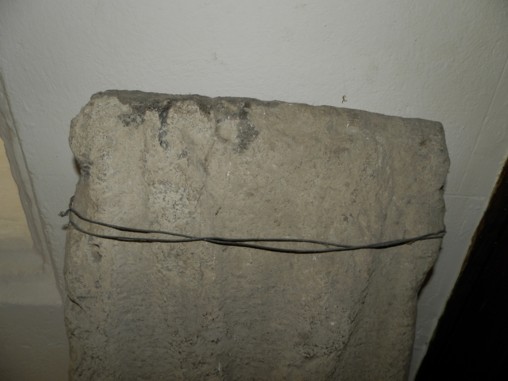
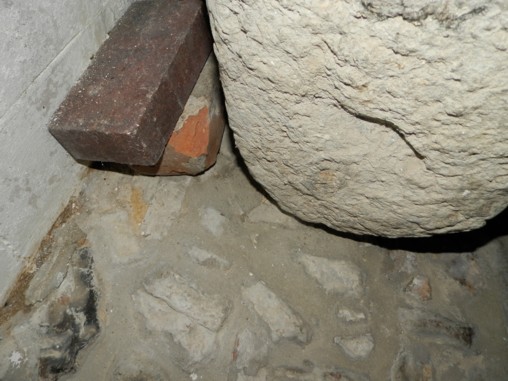
David Parsons suggested in his 2011 contribution to the SAS conference on early medieval churches in Sussex that the schematic outline upon this stone represents a house, with two-dimensional hipped gables at each end: Not a bad explanation... almost plausible, except for a problem; as my partner (who is a trained draughtswoman) rightly pointed out - if this was supposed to represent a hipped gable roof, then the crossbar near either end makes no sense at all!
To our eyes, the outline is much more reminiscent of an Egyptian Ankh, as our zoomed image, (further below) attempts to point out.
There are three distinct possibilities here: 1. the overlay of yellow markings show what could be the very top of the 'Ankh' design outline, (bearing in mind when studying, that this stone has been heavily degraded over the centuries... chipped, chiseled, weathered etc).
2. the red line represent another possibility, the loop-end may have been shortened by at least several inches; it is well chronicled how early Christian priests would often vandalize pagan stones by destroying their symbolism, so that the meaning was changed to reflect their own views. (Note also, how it appears as if several crosses have been later added to the vertical body of this carving).
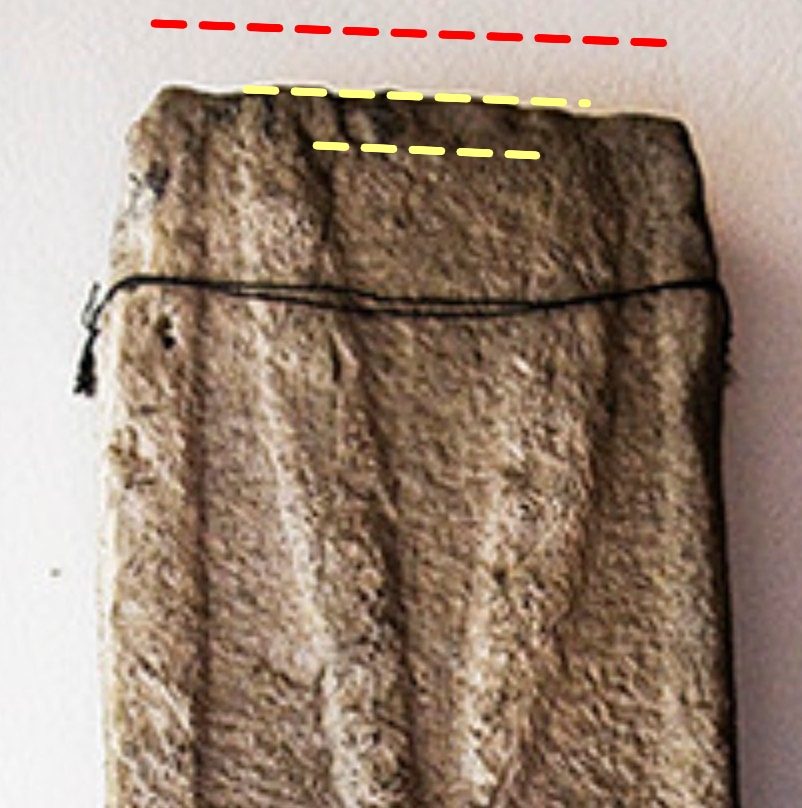

Artist rendering of how the design may have originally looked
3; we even toyed with the idea of a double Ankh emblem; this of course would mean that the slab has been somewhat reduced at both ends! Once resized for use as the church step, or even as a coffin lid perhaps? (plain side up...naturally!)


...and for anyone doubt the double ankh proposal - here below, is a depiction of such a symbol that we discovered by sheer accident while watching a National Geographic documentary about the 'black pharaohs'; this is an ancient Kushite gold bracelet from between 785 BC and 350 AD... please examine and enlarge its center panel.
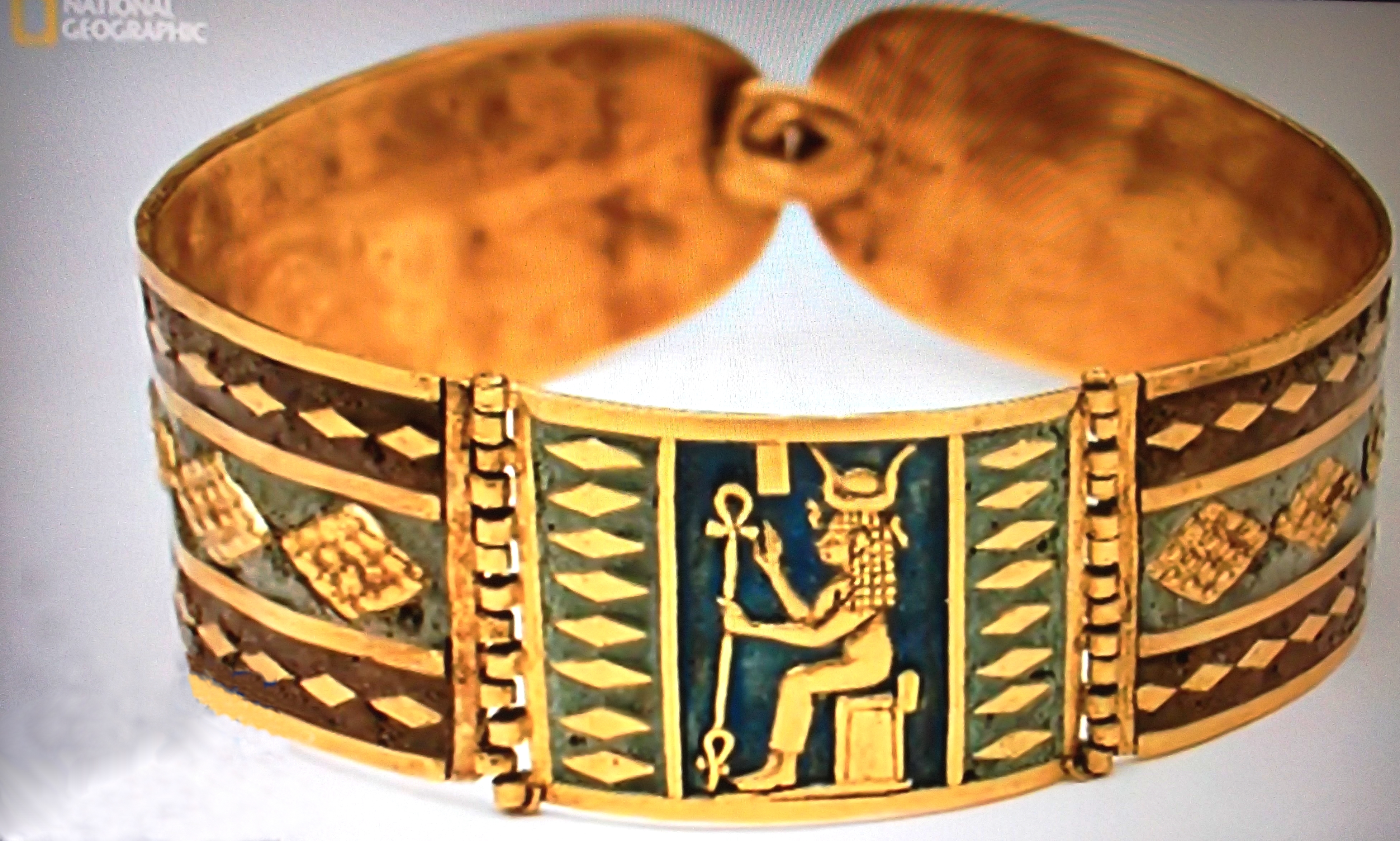


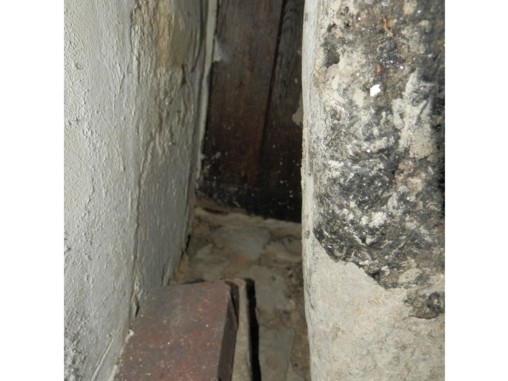
Side-rear of stone (shown in this picture to the right, as the stone is leaning against a wall)
If correct, then this raises a whole new historical controversy.
How could this ankh symbolism have reached Chanctonbury? a name which, (coincidentally?) has the phonetics of Ch-ank-ton-bury.
A quick search on Google revealed that the ank phonetic in British place names is ultra-rare, in fact we couldn't find any other examples at all - but as I say, that wasn't a comprehensive search.
Something else to consider, is that until the late 18th century Chanctonbury was known simply as 'CHANKBURY'. (Chenkburie 1610 and Chankberie in 1587).
[Interesting also is 'Standing Stones in Sussex', (Prestel.co.uk) which informs us about an area of land known as 'The Old Steyne', which once existed on the eastern edge of neighbouring Brighton... again, a name strongly echoing memories of stone worship.]
What we have now nicknamed the 'Ankh' stone, may have been part of a cult which existed in this part of Sussex not long before the Roman period.
We further speculate that the icon could easily have been first brought here by Phoenecian
merchants and introduced to the people of Steyning, who then went on to carve the Ankh stone.
It may not be a widely known part of our history, but for generations these traders had acquired Egyptian articles such as gold, scarabs and stone vases for barter and travelled from their homeland in the eastern Mediterranean to Britain. Historians freely admit that there is evidence of an apparently highly lucrative Phoenician trade with Britain for tin and other goods. Archaeologists have even found items of Mediterranean origin at Stonehenge; these are documented facts.
The Importance of Bramber
Just 0.9 miles away lies Bramber, a small place on the River Adur, north of Shoreham and nestling up to Steyning.

Long ago, Bramber was a far busier place than it is today and served as a bustling port on the Adur river; but like Steyning, as the river silted up and changed its course somewhat, Bramber became redundant as far as seagoing ships were concerned.
We are convinced that this former port is a pivotal clue in all of this, as to just how the Phoenicians visitors may have arrived at Steyning and introduced the Ankh image, (if, that is in fact what we are dealing with here), and/or their unusual religious beliefs.
It must be remembered that the Phoenician religion of life was not only inspired by the heavenly creators, but by creation itself; the powers and processes of nature; in other words, their's was a form of nature veneration; and despite hundreds of years-worth of changes in British fashion, religion and politics, evidence traces that such nature worship persisted in this area at least up until the mid 14th century, still remain in Steyning today.
In more that one work, we have seen it written that Phoenicia was one of the earliest colonies of the Anunnaki on Earth. Check this example out.
So, things are beginning to add up.
Christian builders incorporated a great deal of metaphor in their designs, and often included many Nature deity symbols in order to make Pagans feel welcome to the new religion.
Visitors to the church of St Andrew and St Cuthman are advised to examine its Medieval foliate wood carvings, as well as the beautifully carved Norman arcade; last but not least, there is a fine depiction of the Green Man, (circa 1340), inside 44 High Street, Steyning; this can be found carved upon an oak beam of the building now used as a Post Office. (see image below).
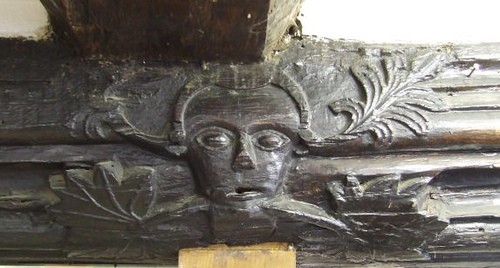
Such foliate heads are said to represent tree worship and fertility; this type of iconography is a remembrance of a long-forgotten way of life.
Finally, we must add one last ingredient into the Steyning/Chanctonbury melting pot of UFOs, Standing Stones, Occult Religion and Christianity, (subjects which are all interconnected at some level in our opinion)... Chanctonbury Hill is also well known by Ley Line enthusiasts for the geomagnetic energy flows, (oft-times measurable through dowsing) which are said to pass through this prominent landmark.
Update:
Please see here for another exciting archaeological discovery recently made in Steyning - something that certainly adds weight to this report.
[Please scroll completely down this page for full story and photos]
The name of Steyning is thought to have arrived from "people of the stone" - or "stones", and in the porch of St Andrew's Church there can be found a curious artifact, the true significance of which has so far proved elusive to academia.
Both Pagan and Christian origins have been proposed for this stone carving, which legend has it was originally "taken from a high place"; and when one stands in Steyning and looks around, the only obvious "high place" near here is Chanctonbury Hill, (home of the mystical Chanctonbury Ring site), which towers 781 feet above sea level over this quaint village.

"Taken from a high place"
Quote from Standing Stones in Sussex: "At first glance it appears to be but a grave slab, but it has been pointed out that the top is weathered but the bottom is not, which would suggest that it has been standing rather than lying on the ground.
He also points out that the cross motif near the center of the stone, the only recognisable Christian symbol, is cut deeper than the other symbols. This he says [seems] to be a later addition, used to 'Christianise' the otherwise pagan stone." end.
This object has previously been referred to in writings as either a "Standing Stone" or a "Menhir".
The above excerpt is used to show how our investigation is clearly not about a mere grave slab; yet, (just as if to confuse matters), there is a grave slab to be found here at this church, (a far thinner, broken stone - see picture below) which is also located iin the porch: It is known as the 'royal grave-slab', and is usually associated with Ęthelwulf of Wessex. Ęthelwulf was buried here in 858, being transferred to Winchester at a later date.

Broken grave slab in Steyning church;
this has two Christian crosses crudely scored into it
and is not in any way comparable to its neighbour
in terms of workmanship.
The two stones are not associated as far as we can
determine - and may not even be the same age.
Together with my partner Hilary, I have stayed at Steyning many times and studied its history in
great depth; and we can reveal to the reader our conclusion that this stone once stood upon Chanctonbury Ring, from whence it was removed, then disguised and placed where it was later discovered during renovation work in 1938... face down and being used as a church step.
We even visited the local museum, (located just across the road from St. Andrew's), to try and find out what they knew about this mysterious artifact, but the staff there seemed most reluctant to elaborate - one of whom even replied "what stone?" when I first dared to ask about it.
Renaming Fiasco
Our inquiring minds were puzzled as to why this pagan creation might have been ripped out from
the Chanctonbury hilltop and taken to a place of Christian sanctity.
It doesn't exactly stretch the bounds of possibility to suggest that the clergy should be our
Number 1 suspects in this whodunnit; an idea further bolstered by a local story that tells how "St. Cuthman felled a stone, which the people of Steyning were worshiping" and "built the first church there around 750 AD."
The building was reconstructed beginning from about 1200 AD, but naturally it was still known as
St. Cuthman's; yet only recently there was a radical attempt to change its denominational reference; even though Cuthman was the founder of this site, it was decided by someone to re-dedicated the church St Andrew's; yet moves began in January 2007 within the parish to have it rededicated to "St Andrew and St Cuthman", giving the apostle Andrew precedence, but reincluding Cuthmann; these moves succeeded and the church is now dedicated to "St Andrew and St Cuthman".
Trampled Under Foot
Trampling on a sacred item has always been considered as an incredibly offensive act, and the
placing of this overturned stone for use as a church step might well have been a symbolic, disrespectful gesture by Cuthman, against what were considered at that time - 'sacrilegious heathens'.


Close
ups: Top and Bottom of stone - note the signs of apparent
cropping/re-fashioning:
Click images to examine in detail.
Click images to examine in detail.
David Parsons suggested in his 2011 contribution to the SAS conference on early medieval churches in Sussex that the schematic outline upon this stone represents a house, with two-dimensional hipped gables at each end: Not a bad explanation... almost plausible, except for a problem; as my partner (who is a trained draughtswoman) rightly pointed out - if this was supposed to represent a hipped gable roof, then the crossbar near either end makes no sense at all!
If
it was a 'house', (or maybe a tomb) that the artist wanted to depict on
this stone,
then why didn't he simply fashion the scene from a side-on perspective?
then why didn't he simply fashion the scene from a side-on perspective?
To our eyes, the outline is much more reminiscent of an Egyptian Ankh, as our zoomed image, (further below) attempts to point out.
There are three distinct possibilities here: 1. the overlay of yellow markings show what could be the very top of the 'Ankh' design outline, (bearing in mind when studying, that this stone has been heavily degraded over the centuries... chipped, chiseled, weathered etc).
2. the red line represent another possibility, the loop-end may have been shortened by at least several inches; it is well chronicled how early Christian priests would often vandalize pagan stones by destroying their symbolism, so that the meaning was changed to reflect their own views. (Note also, how it appears as if several crosses have been later added to the vertical body of this carving).


Artist rendering of how the design may have originally looked
3; we even toyed with the idea of a double Ankh emblem; this of course would mean that the slab has been somewhat reduced at both ends! Once resized for use as the church step, or even as a coffin lid perhaps? (plain side up...naturally!)


...and for anyone doubt the double ankh proposal - here below, is a depiction of such a symbol that we discovered by sheer accident while watching a National Geographic documentary about the 'black pharaohs'; this is an ancient Kushite gold bracelet from between 785 BC and 350 AD... please examine and enlarge its center panel.

The
Ankh:
Anciently, in addition to representing life, the Ankh also symbolised a group of deities, referred to in Mesopotamian/Sumerian legend as the Anunnaki -
Anunnaki, one translation of which reads: "those who from heaven to Earth came"
Anu (Ann) or Anunna= God of the Sky
Ki = Earth
Anu-nna-key or Anoo-naa-qee (Phonetics of 'Anunnaki')
Further translations of the word read "from ANU to ki" or "those sent to earth."
We have come to understand the main reason for these slight variations in translation/interpretation; this is due to the fact that the word "Anunnaki", (in this precise and now most popular form) was originally used ONLY in later Akkadian and Babylonian literature, NOT early Sumerian.
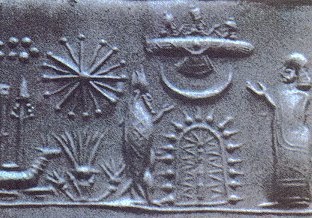
Above: Closeup of a Sumerian cylinder seal that shows the 'Anun'a gods descending from the heavens in a flying craft.
Some scholars believe that the Anunnaki actually created Man, Homo Sapiens, through genetic manipulation with themselves and ape man Homo Erectus.
Intriguing idea; is this in fact what 'the people of the stones' were worshiping back then?
Far-fetched? Maybe not, because Chanctonbury Ring is noted for its very interesting sightings of UFOs.
There are also rumours that the famous occultist Aleister Crowley may have performed rituals at Chanctonbury Ring; because it is recorded that Crowley and one of his disciples, Victor Neuberg of Steyning, both thought the 'Ring' was a "place of Power".
His experiments in channeling to other worlds even brought out another potential UFO connection.
Was Crowley in contact with aliens from another dimension, as some believe?
Is there a bizarre connection between UFOs, occult circles and ancient sites such as Chanctonbury?
Anciently, in addition to representing life, the Ankh also symbolised a group of deities, referred to in Mesopotamian/Sumerian legend as the Anunnaki -
Anunnaki, one translation of which reads: "those who from heaven to Earth came"
Anu (Ann) or Anunna= God of the Sky
Ki = Earth
Anu-nna-key or Anoo-naa-qee (Phonetics of 'Anunnaki')
Further translations of the word read "from ANU to ki" or "those sent to earth."
We have come to understand the main reason for these slight variations in translation/interpretation; this is due to the fact that the word "Anunnaki", (in this precise and now most popular form) was originally used ONLY in later Akkadian and Babylonian literature, NOT early Sumerian.

Above: Closeup of a Sumerian cylinder seal that shows the 'Anun'a gods descending from the heavens in a flying craft.
Some scholars believe that the Anunnaki actually created Man, Homo Sapiens, through genetic manipulation with themselves and ape man Homo Erectus.
Intriguing idea; is this in fact what 'the people of the stones' were worshiping back then?
Far-fetched? Maybe not, because Chanctonbury Ring is noted for its very interesting sightings of UFOs.
There are also rumours that the famous occultist Aleister Crowley may have performed rituals at Chanctonbury Ring; because it is recorded that Crowley and one of his disciples, Victor Neuberg of Steyning, both thought the 'Ring' was a "place of Power".
His experiments in channeling to other worlds even brought out another potential UFO connection.
Was Crowley in contact with aliens from another dimension, as some believe?
Is there a bizarre connection between UFOs, occult circles and ancient sites such as Chanctonbury?


Close
ups: Top side to give idea of stone's depth - and an extreme top view
revealing evidence of crude cutting; click to examine in detail

Side-rear of stone (shown in this picture to the right, as the stone is leaning against a wall)
If correct, then this raises a whole new historical controversy.
How could this ankh symbolism have reached Chanctonbury? a name which, (coincidentally?) has the phonetics of Ch-ank-ton-bury.
A quick search on Google revealed that the ank phonetic in British place names is ultra-rare, in fact we couldn't find any other examples at all - but as I say, that wasn't a comprehensive search.
Something else to consider, is that until the late 18th century Chanctonbury was known simply as 'CHANKBURY'. (Chenkburie 1610 and Chankberie in 1587).
[Interesting also is 'Standing Stones in Sussex', (Prestel.co.uk) which informs us about an area of land known as 'The Old Steyne', which once existed on the eastern edge of neighbouring Brighton... again, a name strongly echoing memories of stone worship.]
What we have now nicknamed the 'Ankh' stone, may have been part of a cult which existed in this part of Sussex not long before the Roman period.
We further speculate that the icon could easily have been first brought here by Phoenecian
merchants and introduced to the people of Steyning, who then went on to carve the Ankh stone.
It may not be a widely known part of our history, but for generations these traders had acquired Egyptian articles such as gold, scarabs and stone vases for barter and travelled from their homeland in the eastern Mediterranean to Britain. Historians freely admit that there is evidence of an apparently highly lucrative Phoenician trade with Britain for tin and other goods. Archaeologists have even found items of Mediterranean origin at Stonehenge; these are documented facts.
The Importance of Bramber
Just 0.9 miles away lies Bramber, a small place on the River Adur, north of Shoreham and nestling up to Steyning.

Long ago, Bramber was a far busier place than it is today and served as a bustling port on the Adur river; but like Steyning, as the river silted up and changed its course somewhat, Bramber became redundant as far as seagoing ships were concerned.
We are convinced that this former port is a pivotal clue in all of this, as to just how the Phoenicians visitors may have arrived at Steyning and introduced the Ankh image, (if, that is in fact what we are dealing with here), and/or their unusual religious beliefs.
It must be remembered that the Phoenician religion of life was not only inspired by the heavenly creators, but by creation itself; the powers and processes of nature; in other words, their's was a form of nature veneration; and despite hundreds of years-worth of changes in British fashion, religion and politics, evidence traces that such nature worship persisted in this area at least up until the mid 14th century, still remain in Steyning today.
In more that one work, we have seen it written that Phoenicia was one of the earliest colonies of the Anunnaki on Earth. Check this example out.
So, things are beginning to add up.
Christian builders incorporated a great deal of metaphor in their designs, and often included many Nature deity symbols in order to make Pagans feel welcome to the new religion.
Visitors to the church of St Andrew and St Cuthman are advised to examine its Medieval foliate wood carvings, as well as the beautifully carved Norman arcade; last but not least, there is a fine depiction of the Green Man, (circa 1340), inside 44 High Street, Steyning; this can be found carved upon an oak beam of the building now used as a Post Office. (see image below).

Such foliate heads are said to represent tree worship and fertility; this type of iconography is a remembrance of a long-forgotten way of life.
Finally, we must add one last ingredient into the Steyning/Chanctonbury melting pot of UFOs, Standing Stones, Occult Religion and Christianity, (subjects which are all interconnected at some level in our opinion)... Chanctonbury Hill is also well known by Ley Line enthusiasts for the geomagnetic energy flows, (oft-times measurable through dowsing) which are said to pass through this prominent landmark.
Update:
Please see here for another exciting archaeological discovery recently made in Steyning - something that certainly adds weight to this report.


